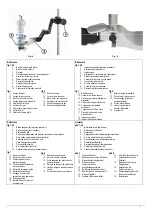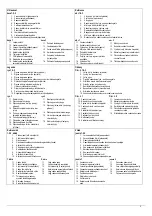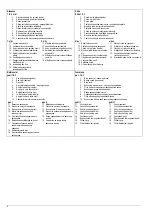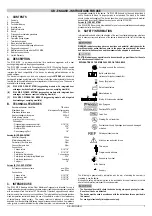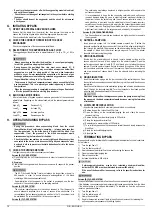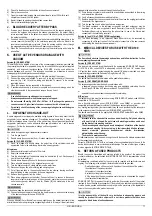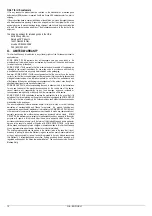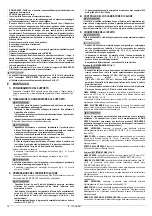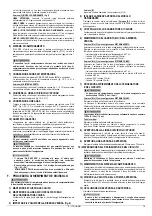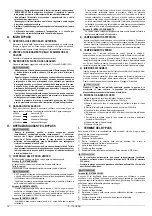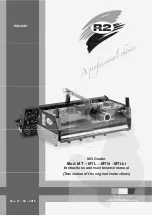
GB - ENGLISH
11
5)
Check for the absence of air bubbles in the soft venous reservoir.
6)
Clamp the venous line.
7)
Open the recirculation/purging line and recirculate at a
rate of 200 ml/min until
complete air removal from the system.
8)
Restart bypass by opening the arterial and venous lines.
9)
Clamp the recirculation/purging line.
J. BLOOD RECOVERY AFTER BYPASS
1)
Drain as much blood as possible from the venous line into the venous reservoir, as
soon as the surgeon has removed the venous cannulae from the patient. Slowly
return recovered blood to the patient by means of the arterial pump, as required by
the patient’s condition.
2)
If needed, blood in the oxygenator may also be returned by adding clear prime to the
venous reservoir (Version [B]: to the cardiotomy reservoir) when the blood in the
reservoir as reached minimum volume. Pump the priming solution slowly through
the oxygenator ensuring that the Venous Reservoir never empties.
3)
When the Venous Reservoir is nearly empty stop the arterial pump and clamp the
arterial line.
K. USE OF ACTIVE VENOUS DRAINAGE WITH
VACUUM
Version [A], OPEN SYSTEM
This method may be applied at any time of the extracorporeal circulation, provided that
the prescriptions below are respected. Using the kit code 096834 or equivalent supplied
separately - and a
vacuum regulation device, D100 KIDS may be used with active
venous drainage with vacuum. This technique constitutes an alternative to venous
drainage by gravity and improves venous drainage .
1)
Open active venous drainage system kit. Maintain sterility of the system.
2)
Connect the tubing end labelled “To reservoir” to the vent connector of the venous
reservoir (fig. 1, ref. 16) and the tubing end labelled “To vacuum” to the vacuum
regulating device.
3)
Close the clamp on the line connected to the reservoir.
4)
If considered necessary to interrupt or suspend active venous drainage, open the
side line connected to the reservoir and remove the cap from it.
-
A controlled vacuum regulating device is required.
-
Always suspend vacuum when the main pump is stopped.
-
Do not exceed -50 mmHg (-6.66 kPa / -0.07 bar / -0.97 psi) negative pressure in
venous reservoir. Higher level of vacuum increases the risk of hemolysis.
-
Periodically check functioning of the vacuum regulating device and the degree
of vacuum.
L. OXYGENATOR
CHANGE-OUT
A spare oxygenator must always be available during bypass in the unlikely event that the
oxygenator in use requires change-out. Procedures lasting longer than 6 hours or if
particular situations where the safety of the patient may be compromised (insufficient
oxygenator performance, leaks, abnormal blood-gas parameters etc.), could require
change out. Follow the steps below to change out the oxygenator.
Use sterile technique during all replacement procedure.
1)
Turn the gas flow off.
2)
Double clamp the venous line (5 cm / 2 inches apart)next to the venous inlet port.
Version [B], CLOSED SYSTEM
3)
Close, by means of a
double clamp, the output line of the cardiotomy and add
appropriate fluids to the cardiotomy to prime the new oxygenator.
All versions
4)
Reduce arterial pump blood flow to 100 ml/min.
5)
Empty the venous reservoir.
6)
Turn the arterial pump off and double clamp the arterial line (5 cm / 2 inches apart)
next to the arterial outlet port.
7)
Double clamp the pump line next to the venous reservoir outlet.
8)
Place a
double clamp next to the oxygenator venous inlet.
9)
Turn the heater-cooler off, clamp and remove the water lines.
10)
Disconnect the gas line, all monitoring and sampling lines.
11)
Cut all required lines in the section between the two clamps, leaving a
sufficient
length of tubing to allow connection to the new oxygenator.
12)
Remove the oxygenator from the holder.
13)
Place a
new oxygenator on the holder. Connect all lines (i.e. venous to the venous
reservoir inlet port, arterial and gas to the oxygenator, pump line to venous reservoir
outlet and oxygenator inlet port, and, for Version [B], the cardiotomy to the soft
venous reservoir).
In this phase, keep the venous and arterial lines clamped.
14)
Connect and open the water lines, turn the heater-cooler on and check the integrity
of the heat exchanger of the new D100 KIDS .
When no Arterial Filter or Bubble Trap is used, slightly open the arterial line clamp till the
arterial blood starts retro-priming the oxygenating module. In this way all the air remained
trapped in the arterial line is removed through the hollow fibres.
15)
Prime the new oxygenator and remove the microbubbles, as described in the priming
and recirculation procedure.
16)
Verify all connections and secure with safety ties.
17)
Remove clamps from the venous and the arterial line, close the purging/recirculation
line and start the bypass again.
18)
Turn the gas flow on and adjust gas flow rate as required.
19)
The blood contained in the replaced oxygenator and heat exchanger may be
transfered into the new oxygenator Venous Reservoir (Version [B]: through the
Cardiotomy Reservoir) by connecting the arterial line to one of the filtered inlet
connectors of the cardiotomy reservoir.
Version [A] and [C] if in OPEN SYSTEM configuration:
20)
The blood remaining in the replaced Venous Reservoir may be recovered by
connecting its outlet port to one of the filtered inlet connectors of the new reservoir
and draining this blood into the new reservoir.
M. MEDICAL DEVICES FOR USE WITH THE D100
KIDS
The User should observe the warnings and cautions and follow Instruction for Use
accompanying the separate device.
Version [A], OPEN SYSTEM
The device must be used in combination with the appropriate SORIN GROUP Adaptor
Kit
3/16-1/4 to MLL code 050575 to adequately connect 3/16” and 1/4” suction lines.
1/8”
suction lines can be connected using the special 1/8” adaptor provided only when
manufacturing preconnected Perfusion Tubing Systems (PTS).
Version [B], CLOSED SYSTEM
The device must be used in combination with a
paediatric cardiotomy.
Version [C], OXYGENATING MODULE
The oxygenating system must be used in combination with:
- a separate venous reservoir functioning also as a
paediatric cardiotomy like the
Sorin
Group D120 Kids HVR venous reservoir PC code 050536;
or
-
a paediatric soft venous reservoir and paediatric cardiotomy.
All Versions
Temperature controls must be carried out using SORIN GROUP probes, code 09026 or
compatible to YSI Series 400.
Use a
Sechrist air/oxygen mixer (SORIN GROUP code 09046) or a
system with
compatible technical features for control of the blood gas concentration and flow.
Any heating/cooling system (thermocirculator) may be used, provided that the connectors
to the oxygenator are of the Hansen type (SORIN GROUP code 09028).
The device must be used with the appropriate SORIN GROUP holder D633 code 05083.
-
Brackets shall be cleaned after each use and when dirty. Only hand cleaning
with a soft cloth is allowed. Do not clean with washing machines and do not
dip the bracket into washing solutions.
-
To achieve adequate cleaning and avoid damages or alterations of the bracket
use water and cleaning fluids containing, in their prescribed dilution volumes,
alcohol, clorexidin gluconate, benzalconium chloride, formaldehide,
glutaraldehide and mild soap.
-
The bracket is maintenance free
All additional devices must be used in conjuction with their specific holders as prescribed
by the respective manufacturers.
Currently SORIN GROUP ITALIA is not aware of any contraindications to the use of the
device with occlusive or non-occlusive peristaltic pumps. The use of other types of pump
must be agreed with SORIN GROUP ITALIA.
N. RETURN OF USED PRODUCTS
Should the user be dissatisfied with anything related to the quality of the product, the
product distributor or the authorized local SORIN GROUP ITALIA representative should
be notified.
All parameters considered critical by the user must be reported with particular care and
urgency. The following is the minimum information that should be provided:
Detailed description of the event and, if pertinent, the conditions of the patient;
Identification of the product involved;
Lot number of the product involved;
Availability of the product involved;
All the indications the user considers useful in order to understand the origin of
the elements of dissatisfaction.
SORIN GROUP ITALIA reserves the right to authorize, if necessary, recall of the product
involved in the notification for assessment. If the product to be returned is contaminated, it
must be treated, packed and handled in conformity with the provisions of the legislation in
force in the country where the product was used.
It is the responsibility of the health care institution to adequately prepare and
identify the product for return shipment. Do not return products that have been
exposed to blood borne infectious diseases.
Summary of Contents for KIDS D100
Page 2: ...2 Fig 1 Fig 3 Fig 2 ...



